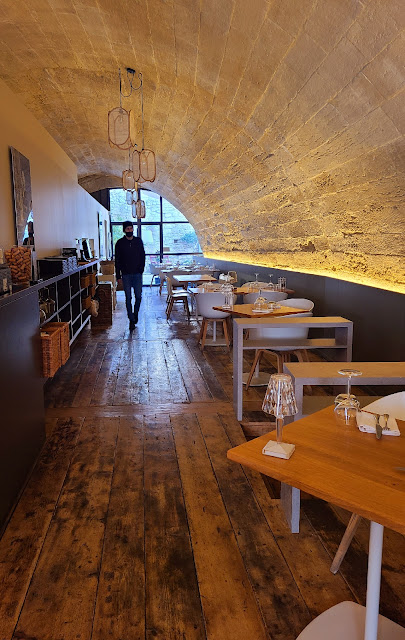It had been quite a few years since we visited Aigues-Mortes so when cousin Jean-Marc suggested we go somewhere on the sea, I suggested we go there. I still recall the first time we went to Aigues-Mortes, years before we bought our house in Sablet, that time with Tante Edith, Jean-Marc's mother.
Aigues-Mortes was founded in 1240 by Louis IX, who was to become Saint Louis on a swampy strip of land along the Mediterranean Sea. The 1st King of France to have a Mediterranean port, he built the future Tower of Constance and a castle which no longer exists, and developed canals towards the sea, Arles and Montpellier. He left from the port of Aigues-Mortes on his crusades in 1248 and 1270.
The Tower of Constance seen below was completed in 1248. The tower is all that remains from the castle built during Louis IX's reign. It was almost certainly the gatehouse tower, designed to be impregnable with its 18 feet thick walls. A spiral staircase leads to the different levels of the tower.
On the top level is a terrace which was used as an outlook post and a lighthouse to guide boats and ensure that they paid their custom duties.
 |
| The Tower of Constance |
The 5,380 feet of city walls were built in two phases; the first during the reign of Philippe III the Bold and the second during the reign of Philippe IV the Fair, who had the enclosure completed between 1289 and 1300. The canal leading to the original port was on the north side of town.
We parked and entered into Aigues-Mortes through the Porte de la Gardette, the town's military gate. It is the only gate with the remains of a drawbridge. It was the only way into town from the 16th to the 18th century.
Place Saint Louis is the main square of Aigues-Mortes in the center of town opposite Porte de la Gardette. In the center stands a monument to Saint Louis installed by James Pradier in 1849.
The Tower of Villeneuve seen below is a good example of a corner tower, designed to provide additional protection.
The towers on the east wall were often places of refuge during the fighting between Roman Catholics and Protestants. Marks left by missiles can still be seen.
The south wall seen below is protected naturally by water where boats have sailed since ancient times. The bottom of the south wall was strengthened with earth excavated to make the Beaucaire canal in the 18th century.
Between 1575 and 1622, Aigues-Mortes was one of eight safe havens granted to Protestants. Upon revocation of the Edict of Nantes (the Edict was promulgated by Henri IV in 1598 and recognized the Protestant religion in the kingdom of France) in 1685, Protestants were subjected to severe repression marked in Languedoc and the Cevennes in the early 18th century by the "Camisard War".
Beginning in 1715, ordinary women, often from the Cevennes (a cultural region and range of mountains in South-Central France on the south-east edge of the Massif Centrale) were imprisoned for having simply attended religious services or simply being suspected of having done so.
Marie Durand, a French Protestant was imprisoned in the Tower of Constance on the 25th August 1730. The exact reason for her imprisonment is not known; perhaps because she attended a Huguenot gathering with her mother, maybe because her brother Peter was a well-known preacher, or perhaps because of her marriage.
Marie was not released until April 14, 1768 after being imprisoned for 38 years. All she needed to do to be released from prison was to renounce her Protestant faith. The word "resister" scratched by her or one of her cell mates with a knitting needle into the stone wall was an expression of her faith. It was recorded that she was asked daily if she would renounce her faith but daily refused.
Upon her release, she returned to her childhood home where she died in September 1776.
The Salins du Midi which is shown below is a salt company in Aigues-Mortes which produces the famous "sel du Camargue". Each year, this area produces 500,000 tons of sea salt. Salt production in Aigues-Mortes goes back to antiquity. In 1856, the various salt marsh owners united to form the Salins du Midi salt company.
A few days after our visit to Aigues-Mortes, I was texting cousin Annick about our visit to Aigues-Mortes. She texted back to say "your grandmother on your father's side was related to the chief Huguenot Pierre Laporte, better known as Roland".
I discovered he was the leader of the Camisards, a band of 1000 men he turned into a disciplined army. He refused to lay down arms until the protections of the Edict of Nantes were restored. He was betrayed to his enemies and was shot on August 14, 1704 while defending himself against his captors.
My cousin ended by saying "you too are linked to this history by your grandmother born in the Cevennes and married to your grandfather Ulysse. Did you know this?" I found out that Roland was born in Mas Soubeyran very close to where my grandmother Jean-Louis was born in the Cevennes.
Going to Aigues-Mortes during the off-season is much better than during the tourist season when it is run over with tourists. This was a very enjoyable visit and we encountered only a few people as we walked the defensive wall and around town.

















































